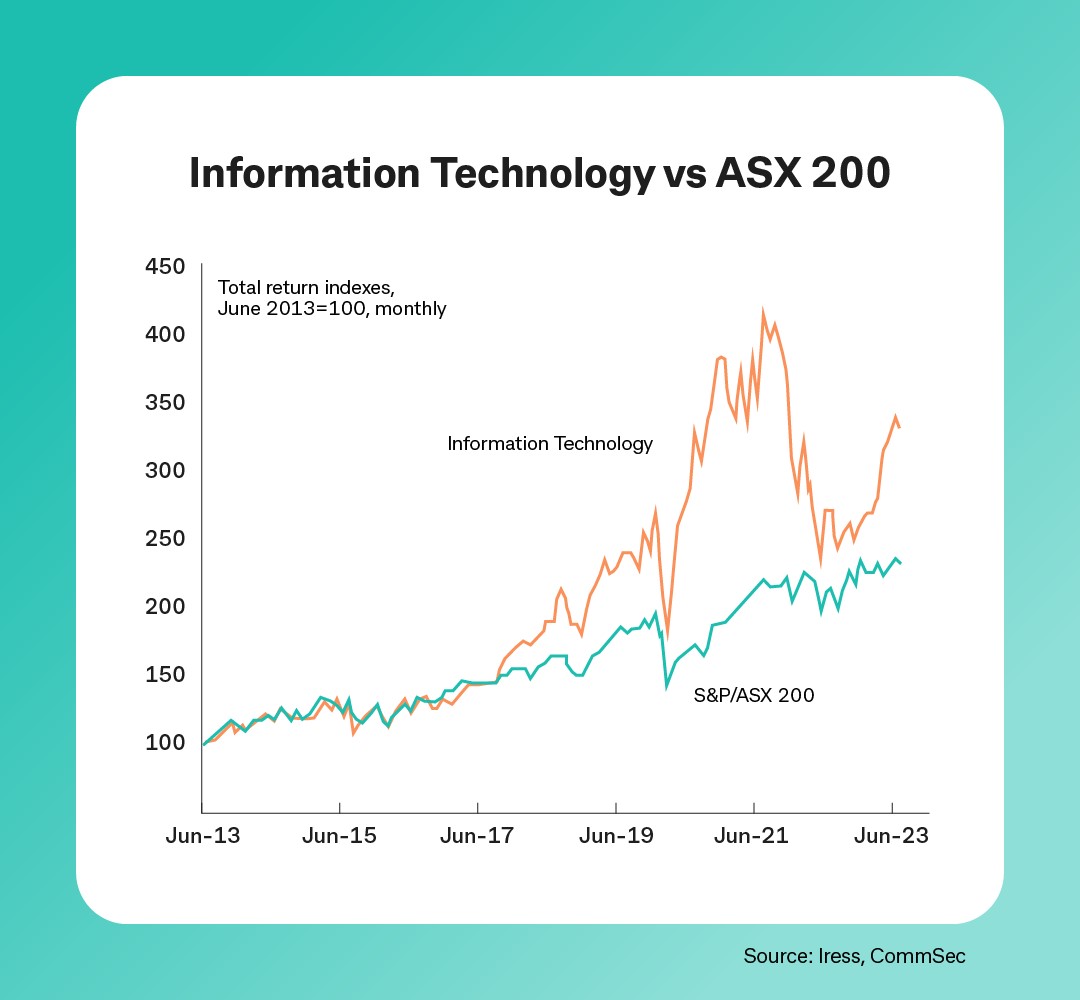
Overview: Information Technology
The S&P/ASX 200 Information Technology sector is the second smallest of the 11 industry sectors. The size, or market capitalisation, of the Information Technology index is $66 billion, around 3% of the $2.1 trillion S&P/ASX 200 index. There are 11 companies in the InfoTech sector. And the sector is dominated by small business accounting software company, Xero, representing around a quarter of the overall sector index.
What sort of companies can be found in the Information Technology sector?
To reiterate, this is one of the smallest sectors on the Australian sharemarket.
The biggest company, Xero (XRO), is the 26th largest company in the ASX 200 index and accounts for a quarter of the InfoTech sector. The company is well known for its accounting and finance software that are used by small businesses.
The second largest company in the sector is Wisetech Global (WTC), around the same share of the InfoTech index. Again think software for companies involved in ‘logistics’ – more broadly, international trade – including customs, freight, warehousing.
Companies No.3 & No.4 by size are Nextdc (14% of the index) and Altium (12% of the index).
Amongst other things, Nextdc (NXT) operate data centres but also functions like disaster recovery. If you have a technology emergency, it is good to know you have a backup.
And Altium (ALU) provide software that assist in designing electrical and electronic equipment. The company serves a broad range of sectors including defence, military, transport and biosciences.
The other companies represented in the ASX 200 Tech sector are:
Technology One Limited (TNE)
Life360 Inc. (360)
Megaport Limited (MP1)
Audinate Group Ltd (AD8)
IRESS Limited (IRE)
Siteminder (SDR)
Data#3 Limited (DTL)
Why would you invest in Information Technology?
Technology is central to the operation of any company. You may not have said this 40-50 years ago. But now if your computer hardware, software and controls aren’t functioning then the company isn’t functioning – or at least not efficiently.
But it’s not just about having the technology to run your business, it’s about growth. And Information Technology is a sector usually identified with the growth of companies, industries and the broader economy.
What are the risks of investing in Information Technology?
As will now be apparent, the listed technology sector in Australia is relatively small. And not just small in relation to other sectors, but also from a global perspective.
In the United States the S&P 500 Information Technology sector is made up of 65 members with market capitalisation US$11 trillion.
Certainly the Aussie InfoTech sector includes companies with significance and relevance in niches of the technology industry. But the grouping in the S&P/ASX 200 represents only 11 companies. If we expand our vision to the broader S&P/ASX 300 index there are 19 companies.
As is always the case, investors can get exposure to the Information Technology sector directly by buying shares in companies represented in the sector. But there are also a number of exchange traded funds (ETFs) that are offered.
Of course, investing in any single sector or company always carries risk, which should be assessed and weighed against your general risk tolerance and investment strategy.
Thinking of investing globally in Information Technology?
When thinking of technology companies, the minds of most investors immediately turn to the US. And in particular the interest concerns a grouping of companies called the Magnificent Seven: Apple, Microsoft, Amazon, Google, Nvidia, Tesla, and Meta (Facebook).
These are truly significant companies. In fact, the market cap of Apple is 1.5 times that of the entire S&P/ASX 200 index.
While investors have the option of investing in Aussie tech firms, they also have the opportunity to invest in the global tech giants. And exposure can be achieved by buying shares in the companies individually or through ETFs and also managed funds.
How has the Australian Information Technology sector performed over time?
Over the past decade, the Information Technology sector of the sharemarket has out-performed the broader ASX200 index. Total returns on the Information Technology sector have lifted 13.3 per cent on average per annum, above the 8.4 per cent per annum lift for the ASX 200 index.

While the Information Technology share price index has lifted 11.3 per cent a year, dividends have risen on average by 2.0 per cent a year. In contrast, the ASX 200 share index has increased at a slower 4 per cent a year while dividend growth has averaged 4.4 per cent a year.
That said, Information Technology was the second-worst performer behind Energy when measuring the biggest annual drop in returns over the past decade. That is to say, while it may have performed above average from a returns point of view, the sector is more likely to record a large fall in returns in any one year, as shown by its performance during and after COVID-19. In other words, the performance of the sector and individual companies has potential to be more volatile.
Final thoughts before you invest
Investors may be attracted to Information Technology companies on the belief that returns will out-perform more mature industry sectors, where shareholder returns may be more driven by dividends rather than capital growth.
But, as always, past performance is no guarantee of future returns. It is always important to take into account the management and strategy of the company, the industry that it operates in, presence of pricing power, financial track record as well as the current and prospective economic environment.
What are the long-term investment trends?
What are secular investing trends, and the biggest secular trends impacting sharemarkets today.
Six ways to research a stock before you buy
You wouldn’t plan a holiday without researching your destination. The same rule applies to investing. Here are six straightforward ways to research a stock before you buy.
Lessons from the dotcom
What happened during the dotcom era and is the same thing happening today? We take a closer look.
Important information
Commonwealth Securities Limited ABN 60 067 254 399 AFSL 238814 (CommSec) is a wholly owned but non-guaranteed subsidiary of the Commonwealth Bank of Australia ABN 48 123 123 124 AFSL 234945. CommSec is a Market Participant of ASX Limited and Cboe Australia Pty Limited (formerly Chi-X Australia Pty Limited), a Clearing Participant of ASX Clear Pty Limited and a Settlement Participant of ASX Settlement Pty Limited.
This information is not advice and is general in nature. The information has been prepared without taking account of the objectives , financial situation or needs of any particular individual. For this reason, any individual should, before acting on this information, consider the appropriateness of the information, having regards to the individual's objectives , financial situation or needs, and, if necessary, seek appropriate professional advice. You can view the CommSec Terms and Conditions, Product Disclosure Statements, Best Execution Statement and Financial Services Guide, and should consider them before making any decision about these products and services.
Past performance is no guarantee of future performance.




